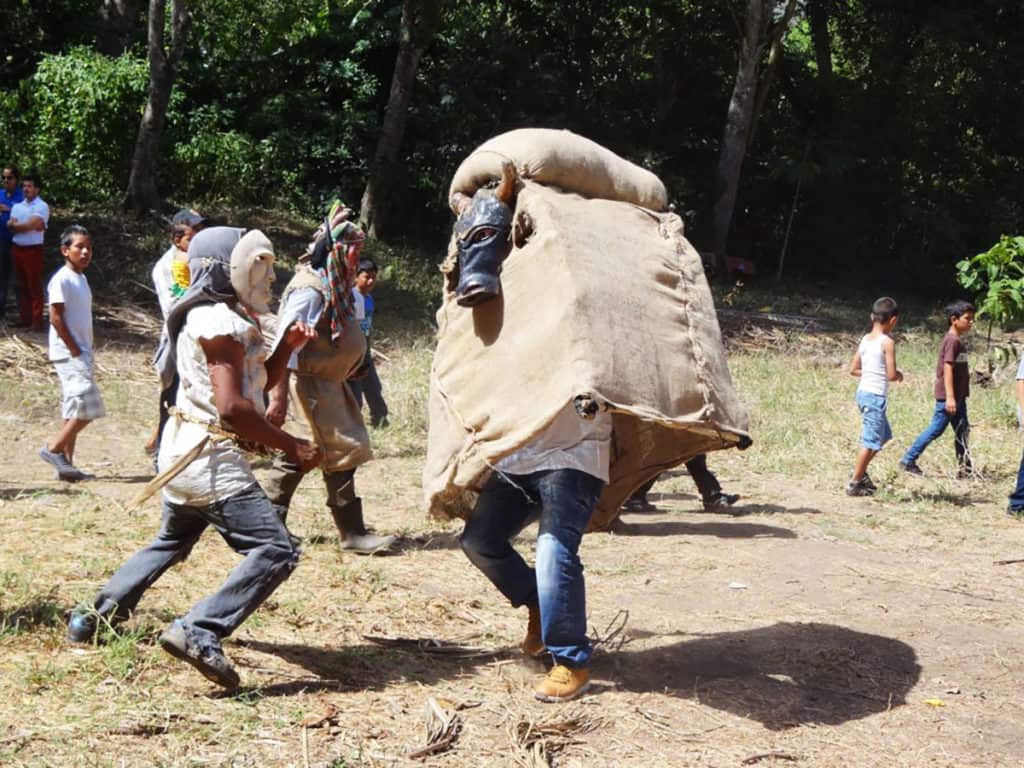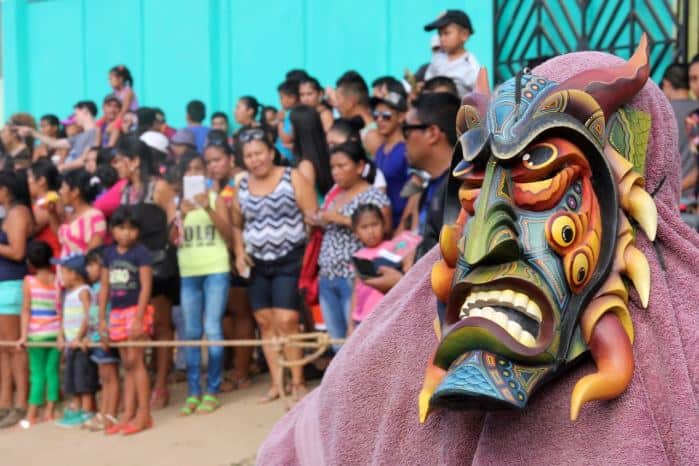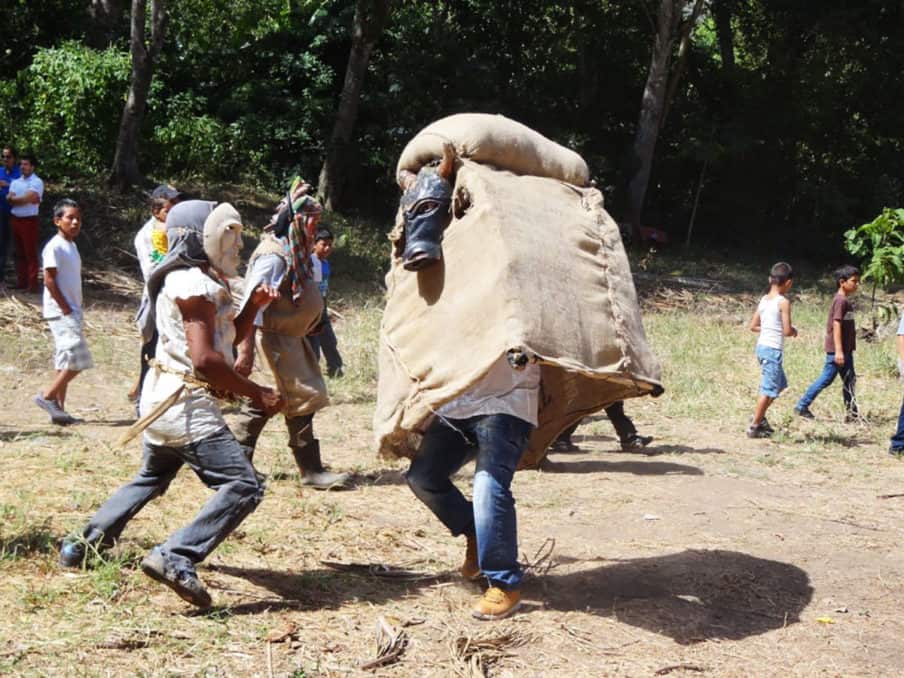
The Fiesta de los Diablitos is a Boruca festival in Costa Rica’s Puntarenas Province, held annually from December 30 to January 1. This indigenous celebration honors the Boruca people’s resistance against Spanish colonizers in the 16th century. Participants wear carved cedar masks and colorful costumes as “diablitos,” dancing and reenacting their triumph over the Spanish. A similar festival occurs in February in the Brunka community of Rey Curré. This event unites the Boruca, passing traditions to new generations.
Celebrating the Fiesta de los Diablitos
The Fiesta de los Diablitos centers on a traditional Costa Rican dance, commemorating the Boruca’s victory over Spanish conquistadors. The Spanish called the Boruca “diablitos” (little devils), believing their non-Catholic beliefs were devilish. The Boruca embraced the name, wearing hand-carved cedar masks resembling devils, animals, or exaggerated faces.
The masks, crafted with traditional tools, are painted with natural pigments and adorned with feathers or banana leaves. Dancers wear body paint and sackcloth costumes, performing a mock battle against a bull, symbolizing the Spanish. Women and children prepare chicha (fermented corn drink) and tamales to share. Drummers and flutists play Boruca music, punctuated by conch shell blasts, mixing indigenous spirituality with Catholic influences. The diablitos’ “resurrection” after “death” symbolizes rebirth and endurance. Tourists are welcome, but the Boruca reserve’s remote location requires planning.
Weeks before, the community gathers to carve masks and rehearse dances, strengthening bonds. Visitors can join these preparations through local guides, gaining insight into Boruca traditions.
When Is the Danza de los Diablitos?
The festival spans three days, from December 30 to January 1, occasionally extending to January 2. On December 30, male dancers gather on a local mountain under the chief Diablo, a tribal elder directing the event. He blows a conch to start the festivities, and village church bells ring. The diablitos dance into the village, playing drums and flutes, continuing until 2 a.m. with brief breaks.
On December 31 at 9 a.m., the torro (bull), representing the Spanish, appears. Boruca men take turns wearing the bull costume, chased by diablitos in a mock battle. This continues for two days. The diablitos resist the bull, “die,” and are “resurrected,” then hunt the bull to the river. On the final day, the bull’s costume (minus the mask) is burned, symbolizing the Boruca’s triumph.
The History of the Dance
The Danza de los Diablitos, though a modern festival, tells a 500-year-old story. It began as a way to scare off Spanish invaders. Despite the conquistadors’ advanced weapons, the Boruca prevailed, preserving their culture. Over time, the ritual shifted from intimidation to a celebration of Boruca endurance, outlasting the Spanish Empire for centuries.
The dance shows the Boruca’s ability to adapt, combining indigenous beliefs with Catholic elements from the Spanish. The “resurrection” of the diablitos reflects spiritual rebirth and defiance against cultural loss. This storytelling through dance keeps the Boruca’s history alive, honoring their ancestors’ strength.
Oral traditions passed down by elders shape the dance’s choreography, with each movement symbolizing resistance. These stories, shared around fires, connect young Boruca to their past.
The Boruca People and Their Masks

The Boruca are an indigenous group on Costa Rica’s Pacific coast, mainly in a Puntarenas Province reserve near Panama. Once dominant, their population is now about 2,600. They defended their lands against empires like the Aztecs and later the Spanish. Known for weaving and woodworking, they create diablito masks, a cornerstone of their artistry.
These masks, carved from cedar wood, depict humans, animals like jaguars or eagles, or devilish faces. Painted with natural pigments and decorated with feathers or leaves, they’re worn during the Danza de los Diablitos. Mask-carving is a dying art, with elders struggling to teach younger generations. The Boruca’s language is nearly extinct, and many sustain themselves by selling crafts, like masks and textiles, to tourists. Learn more about Boruca crafts.
Preserving Boruca Traditions
The Fiesta de los Diablitos keeps Boruca culture thriving, but traditions like mask-carving are at risk. The Boruca Cultural Center teaches youth crafting skills, and in 2023, UNESCO recognized Boruca artistry as intangible cultural heritage (UNESCO). Mask and textile sales through fair-trade cooperatives support the community’s economy. Deforestation threatens cedar supplies, so sustainable practices are emerging.
Local schools teach Boruca history and craft workshops, building pride among young people. The annual Boruca Art Fair, held during the festival, displays masks and textiles, drawing global interest and supporting cultural exchange. These efforts help keep Boruca traditions alive for future generations.
Experience the Fiesta
The Fiesta de los Diablitos offers a glimpse into Boruca resilience. Plan a visit to the Boruca reserve in late December, or buy their crafts online to support this culture. Hear the drums, see the masks, and celebrate a people who’ve thrived against the odds.
Stay with a Boruca family through community-based tourism to learn mask-carving or taste homemade chicha. Respectful visitors are welcomed, but expect rustic conditions and limited amenities. Engaging directly with the Boruca strengthens their efforts to maintain their heritage. Book early, as rooms fill quickly during the festival.

